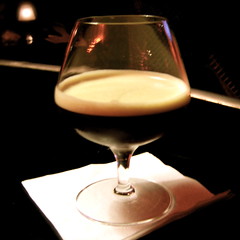Fourteen: Scotch Fusion
We're going to try something a bit new this week: a brief trip into a confused mind.
The thought goes something like this: we know that the action of shaking with ice affects the liquid in the shaker in a couple of noticeable ways:
- it chills the contents, courtesy of the ice
- it adds dilution to the contents, again thanks to the ice
- the motion thoroughly mixes the liquids within
- it aerates the contents by trapping small bubbles of air within the mixture
The first three effects are also observed with stirred and built drinks, but the fourth is unique to shaken drinks. The first three effects can also be observed in warmed or hot cocktails through the addition of boiling water - a Blue Blazer, for example. Continuing the original thought, would it be possible to create a hot cocktail that is aerated by shaking?
Unfortunately, while ice has the handy properties of reducing temperature while also adding solid matter to aid the physical motion of shaking, there isn't an easy alternative for increasing temperature while adding solid matter. Hot coals, possibly, but I didn't have any handy and there's a possibility of the final drink tasting all carbony. At any rate, I decided to try the same recipe twice - one cold, one hot. Just to see if it's possible.

Cold
25ml Johnnie Walker Black Label
25ml Drambuie
25ml espresso
5ml sugar syrup
Shake with ice and fine-strain into a chilled brandy glass. No garnish.
***
The cold version turned out much as expected - a rounded, Scotch twist on an Espresso Martini. For the hot version, I opted to add 40ml of boiling water to add the dilution that would normally come from the ice, and popped the spring from a Hawthorne strainer into the tin as well.
Hot
25ml Johnnie Walker Black Label
25ml Drambuie
25ml espresso
5ml sugar syrup
40ml boiling water
Dry-shake with the spring from a Hawthorne strainer, and strain into a warmed brandy glass. No garnish.
***
The hot version turned out, well, weird. It looked the same as the cold one, but the crema formed by shaking the espresso quickly disappeared. The other notable difference was the temperature - it came out of the shaker more towards lukewarm and didn't retain what heat it had for long either. The dissipation of the crema can - I think - be attributed to the difference in temperature (colder temperatures encourage molecules to stay closer together, if my memory of high school chemistry serves) but I think there are steps I could take to preserve a higher temperature - perhaps using a vacuum flask rather than a regular Boston shaker and heating the ingredients beforehand.
There's something here, maybe. Maybe not; but even at a slightly disappointing temperature, the hot version had both striking similarities and dramatic differences to its cold brother. Returning finally to the thought that started this whole diversion, can you create a hot cocktail that is aerated by shaking?
Almost.